Study on elastic deformation of substitution alloy ab with interstitial atom C and BCC structure under pressure
The analytic expressions of the free energy, the mean nearest neighbor distance
between two atoms, the elastic moduli such as the Young modulus E, the bulk modulus K,
the rigidity modulus G and the elastic constants C11, C12, C44 for substitution alloy AB
with interstitial atom C and BCC structure under pressure are derived from the statistical
moment method. The elastic deformations of main metal A, substitution alloy AB and
interstitial alloy AC are special cases of elastic deformation for alloy ABC. The theoretical
results are applied to alloy FeCrSi. The numerical results for alloy FeCrSi are compared
with the numerical results for main metal Fe, substitution alloy FeCr, interstitial alloy FeSi
and experiments.
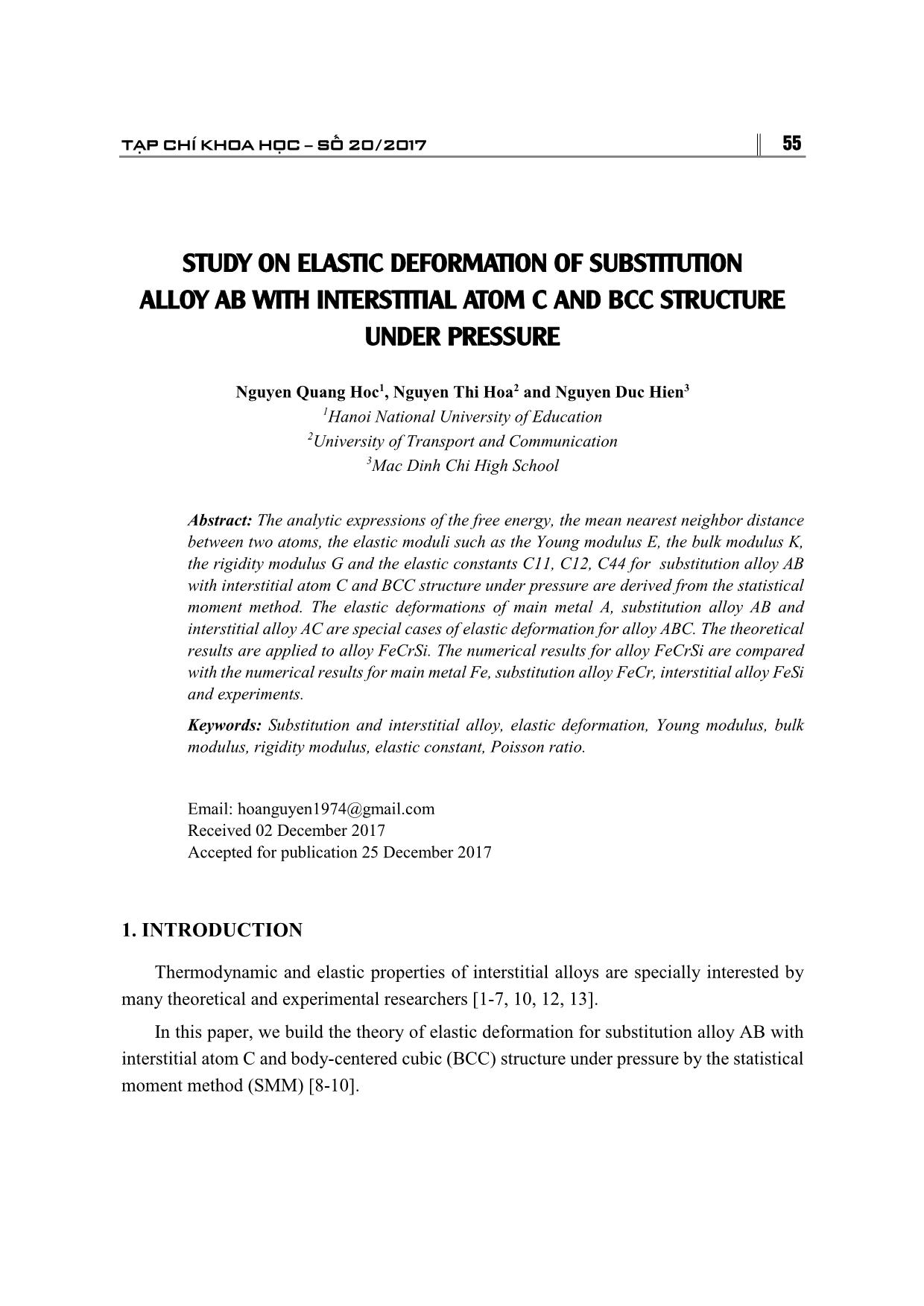
Trang 1
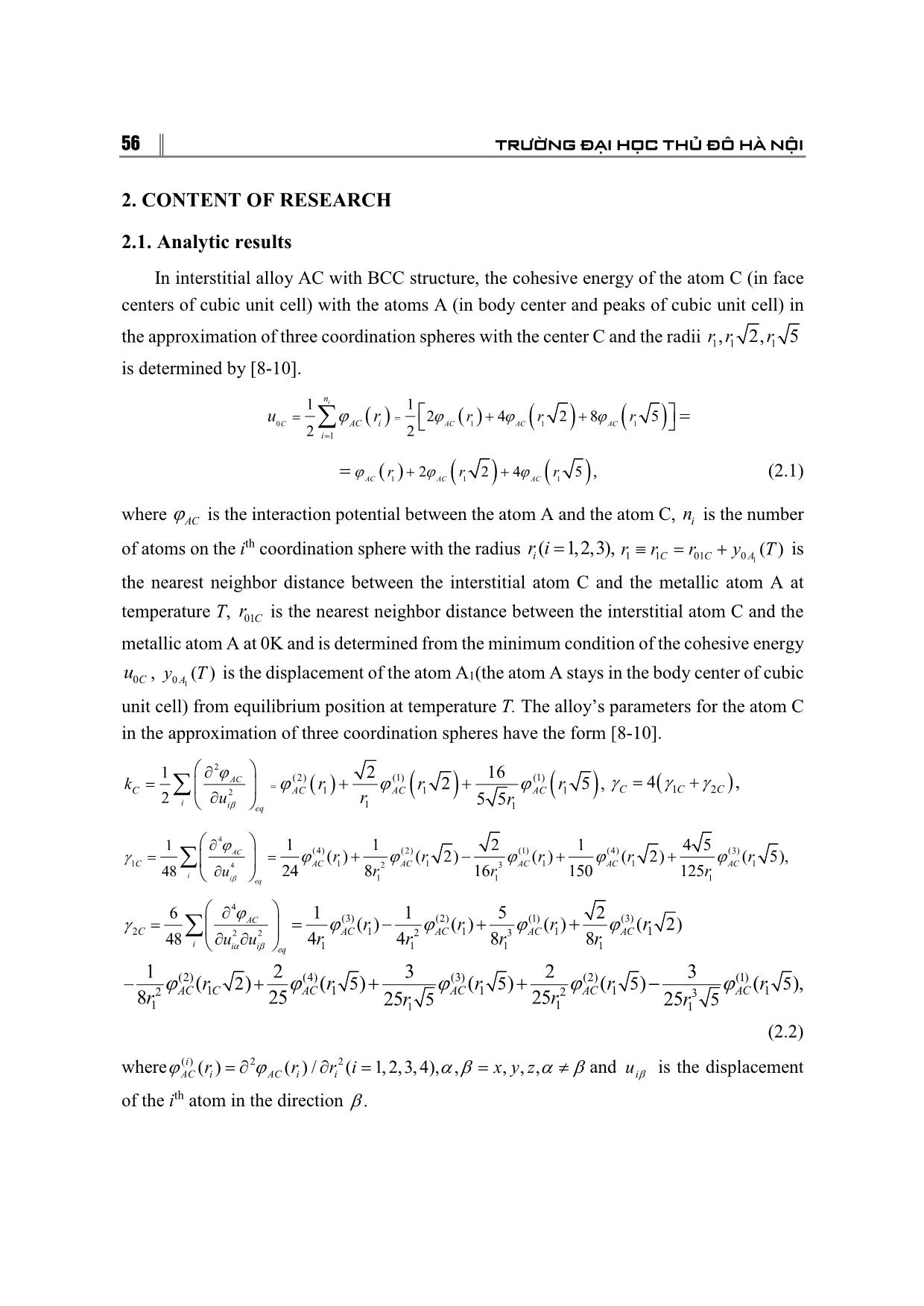
Trang 2
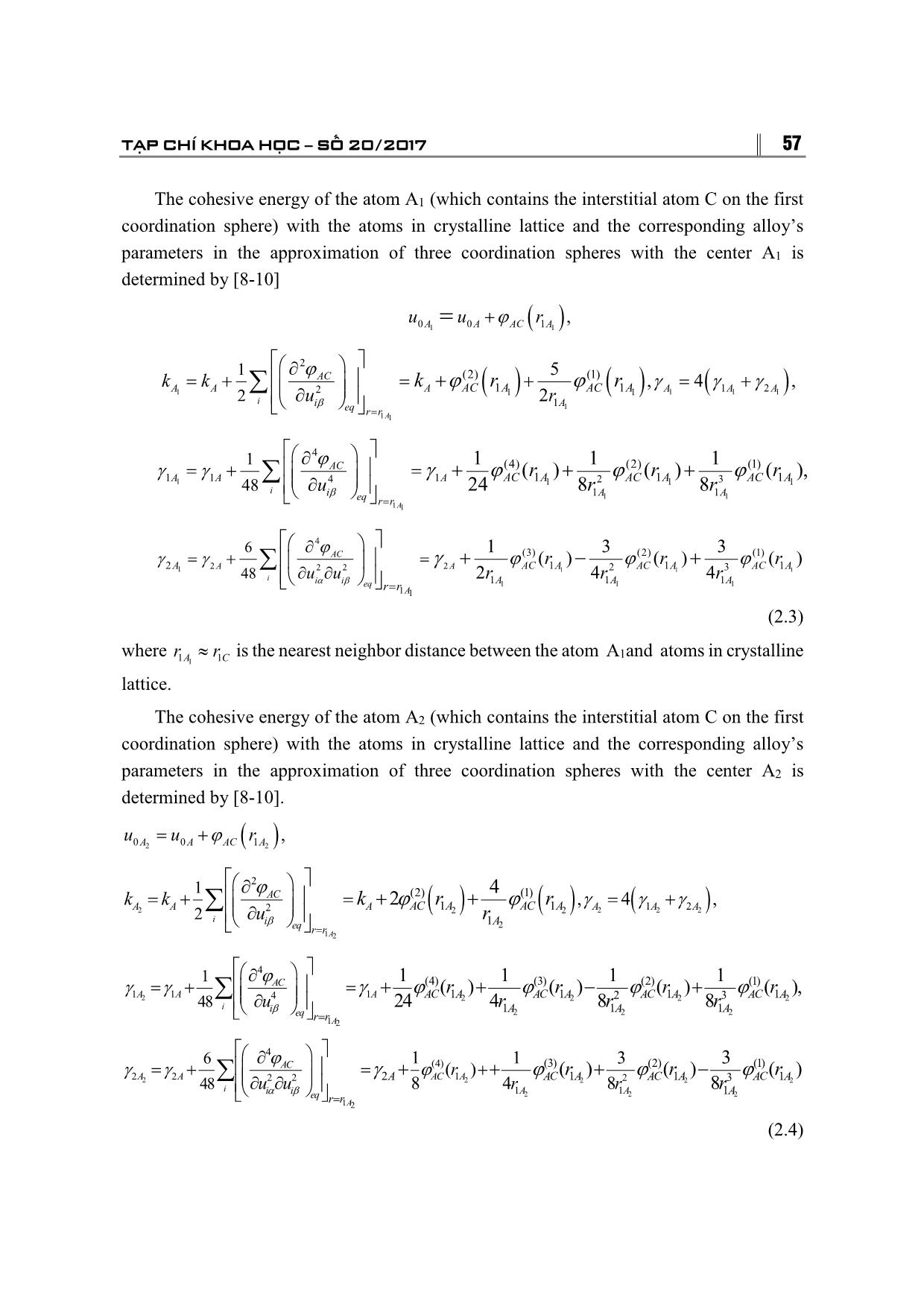
Trang 3
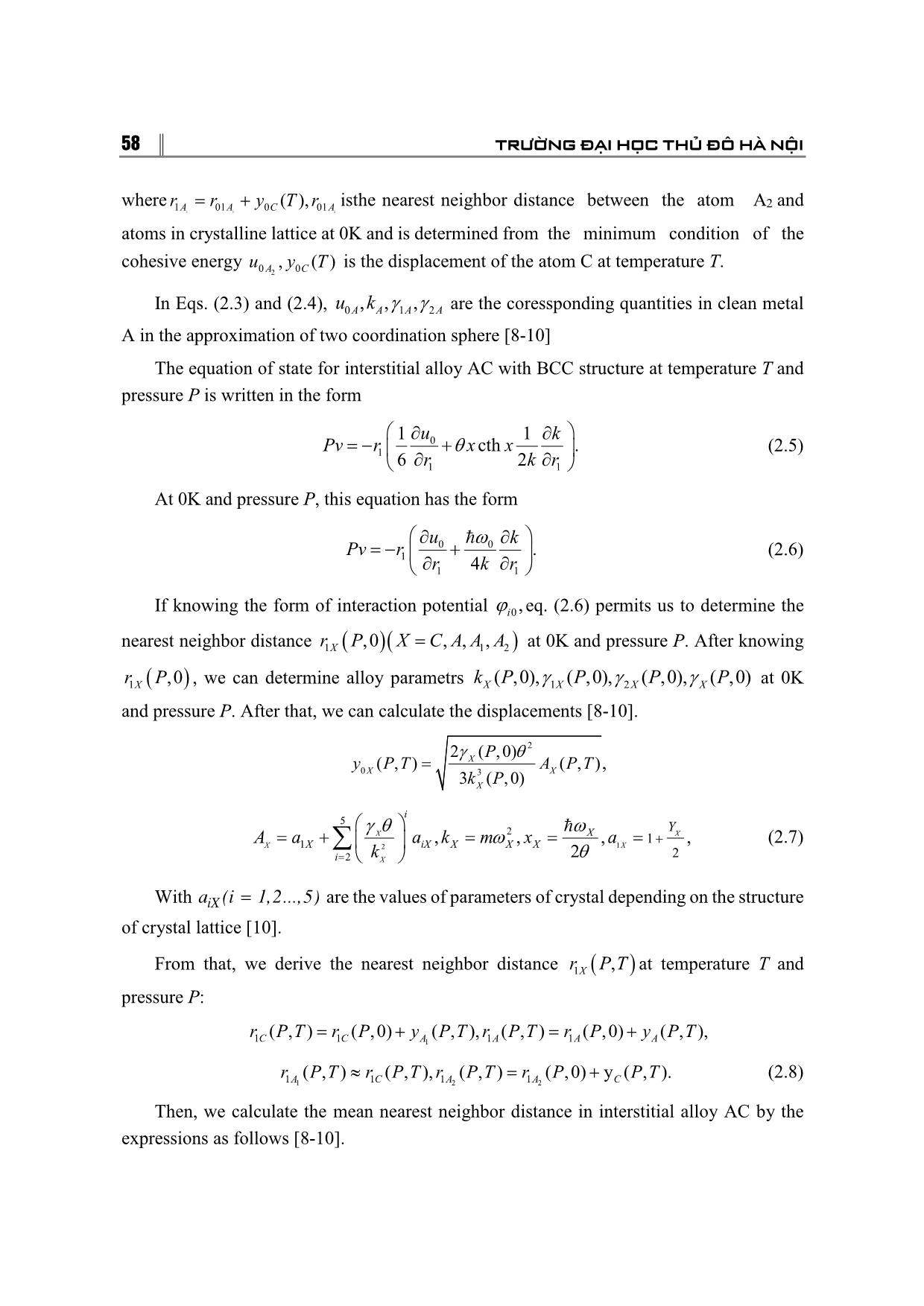
Trang 4
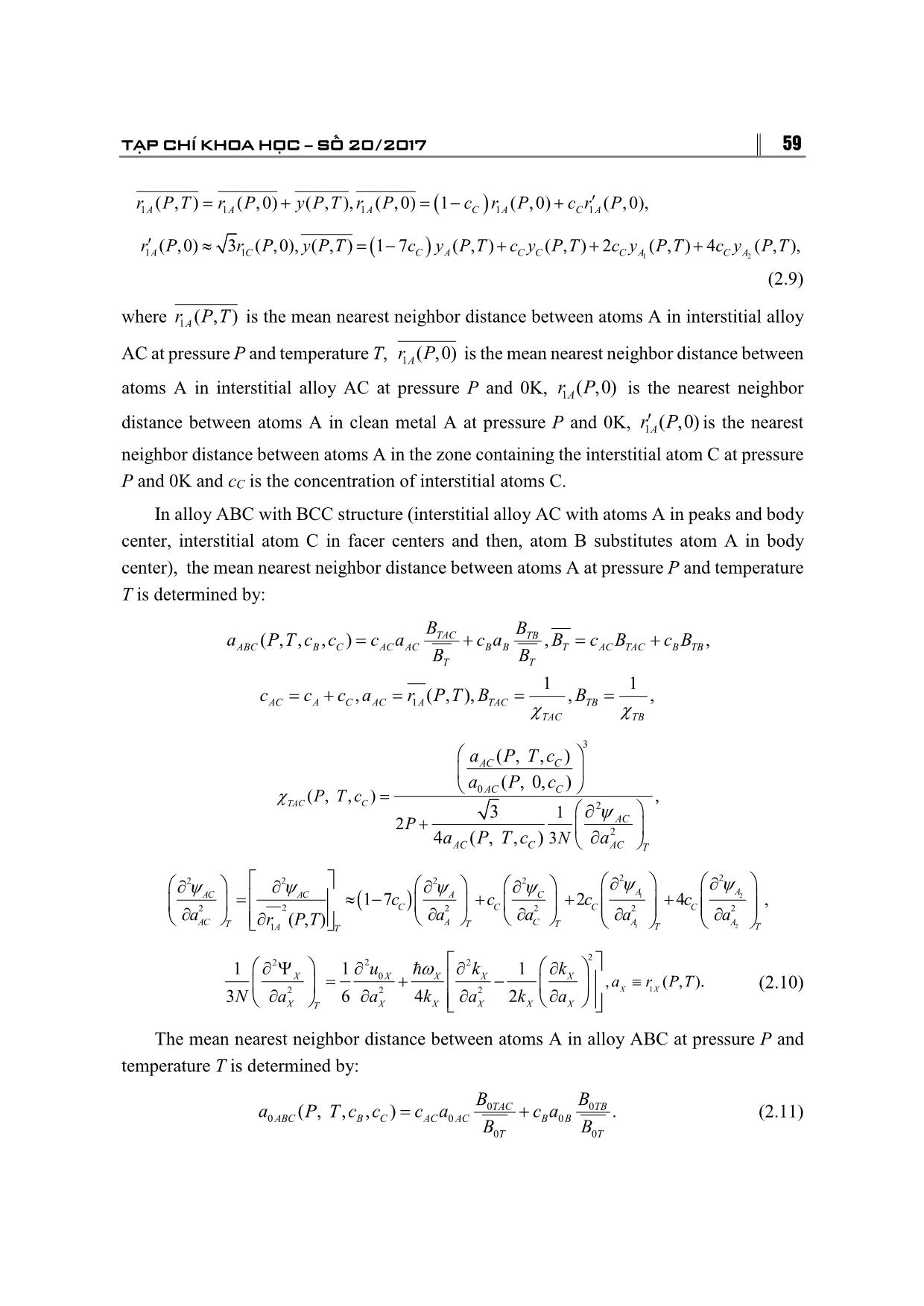
Trang 5
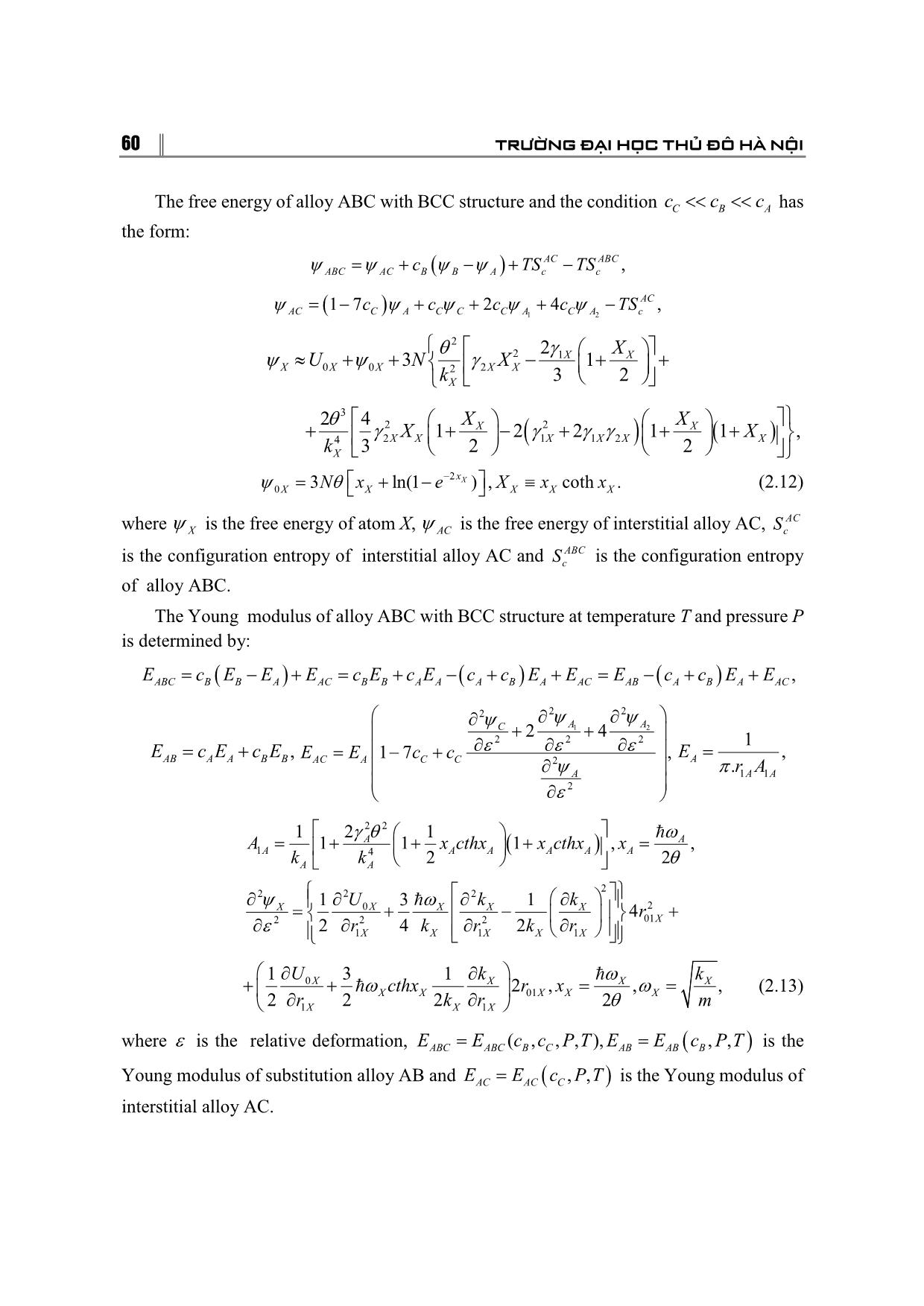
Trang 6
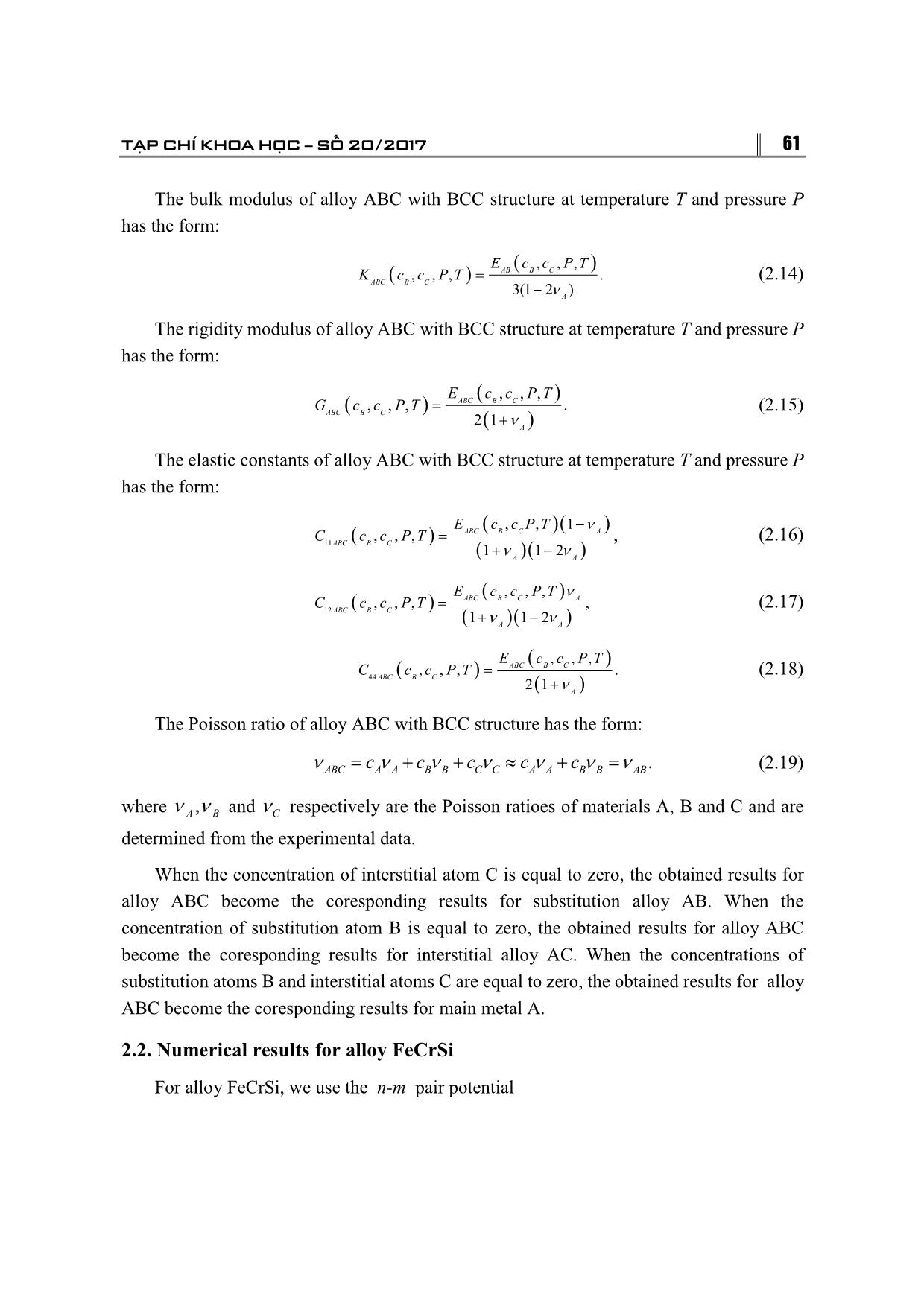
Trang 7

Trang 8
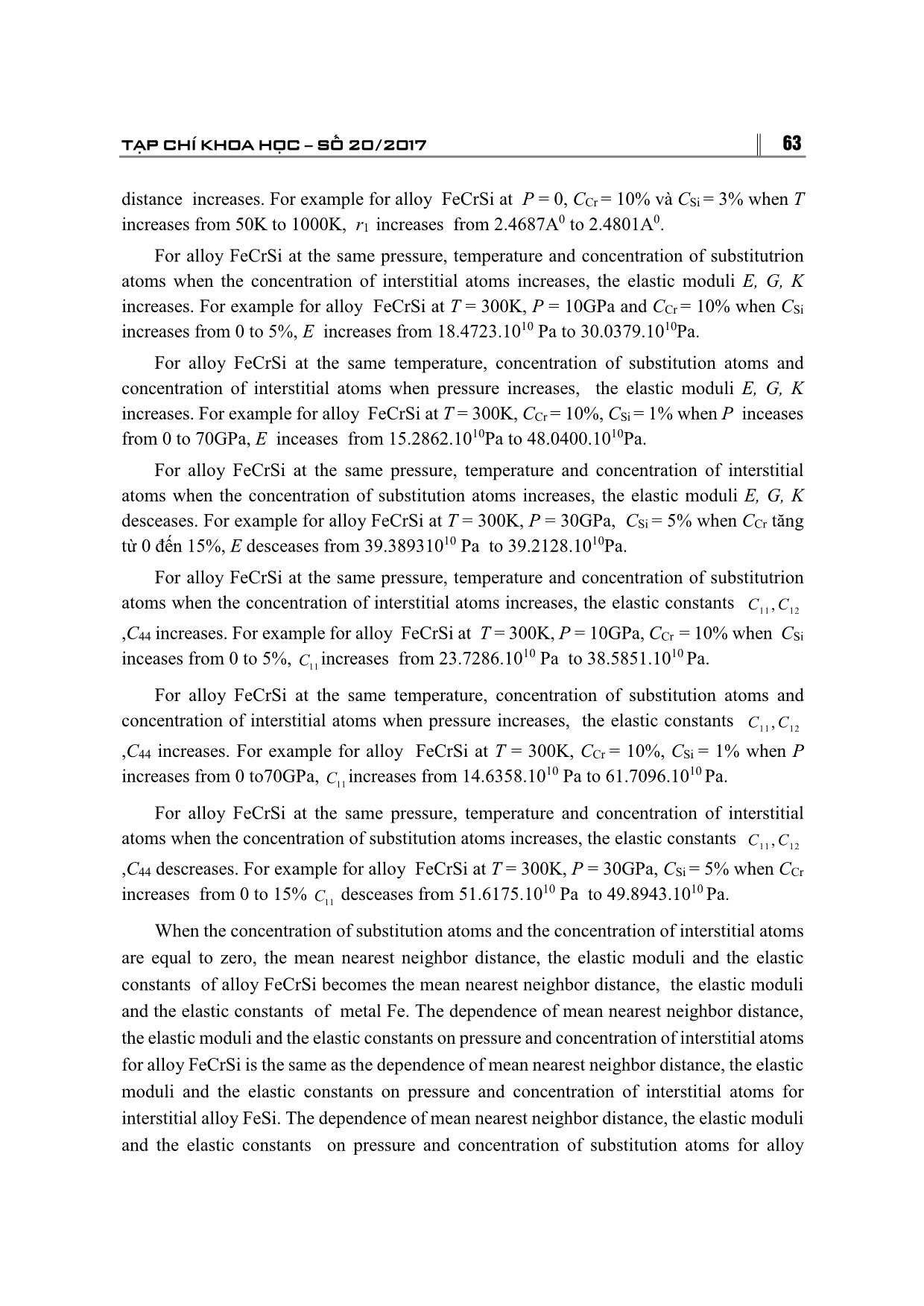
Trang 9
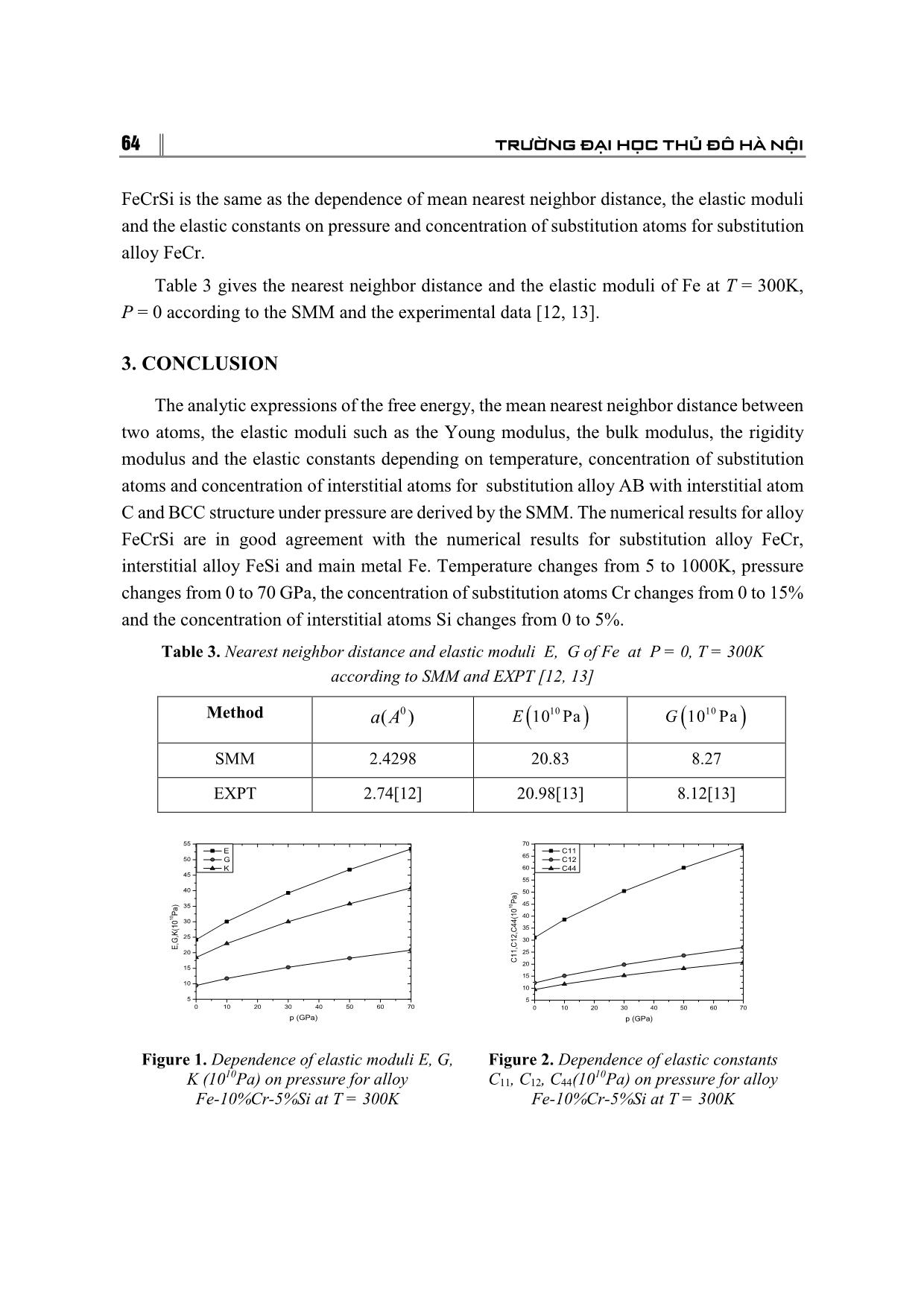
Trang 10
Tải về để xem bản đầy đủ
Tóm tắt nội dung tài liệu: Study on elastic deformation of substitution alloy ab with interstitial atom C and BCC structure under pressure
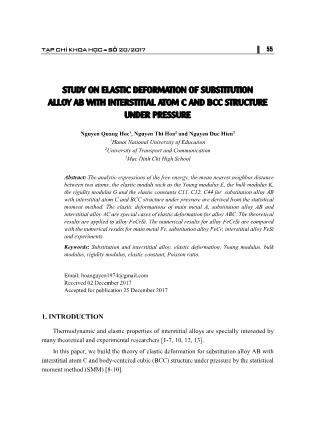
TẠP CHÍ KHOA HỌC SỐ 20/2017 55 STUDY ON ELASTIC DEFORMATION OF SUBSTITUTION ALLOY AB WITH INTERSTITIAL ATOM C AND BCC STRUCTURE UNDER PRESSURE Nguyen Quang Hoc1, Nguyen Thi Hoa2 and Nguyen Duc Hien3 1Hanoi National University of Education 2University of Transport and Communication 3Mac Dinh Chi High School Abstract: The analytic expressions of the free energy, the mean nearest neighbor distance between two atoms, the elastic moduli such as the Young modulus E, the bulk modulus K, the rigidity modulus G and the elastic constants C11, C12, C44 for substitution alloy AB with interstitial atom C and BCC structure under pressure are derived from the statistical moment method. The elastic deformations of main metal A, substitution alloy AB and interstitial alloy AC are special cases of elastic deformation for alloy ABC. The theoretical results are applied to alloy FeCrSi. The numerical results for alloy FeCrSi are compared with the numerical results for main metal Fe, substitution alloy FeCr, interstitial alloy FeSi and experiments. Keywords: Substitution and interstitial alloy, elastic deformation, Young modulus, bulk modulus, rigidity modulus, elastic constant, Poisson ratio. Email: hoanguyen1974@gmail.com Received 02 December 2017 Accepted for publication 25 December 2017 1. INTRODUCTION Thermodynamic and elastic properties of interstitial alloys are specially interested by many theoretical and experimental researchers [1-7, 10, 12, 13]. In this paper, we build the theory of elastic deformation for substitution alloy AB with interstitial atom C and body-centered cubic (BCC) structure under pressure by the statistical moment method (SMM) [8-10]. 56 TRƯỜNG ĐẠI HỌC THỦ ĐÔ HÀ NỘI 2. CONTENT OF RESEARCH 2.1. Analytic results In interstitial alloy AC with BCC structure, the cohesive energy of the atom C (in face centers of cubic unit cell) with the atoms A (in body center and peaks of cubic unit cell) in the approximation of three coordination spheres with the center C and the radii 1 1 1, 2, 5r r r is determined by [8-10]. 0 1 1 1 1 1 1 2 4 2 8 5 2 2 i C AC AC AC n AC i i r r ru r 1 1 12 2 4 5 ,AC AC ACr r r (2.1) where AC is the interaction potential between the atom A and the atom C, in is the number of atoms on the ith coordination sphere with the radius ( 1,2,3),ir i 11 1 01 0 ( )C C Ar r r y Tº is the nearest neighbor distance between the interstitial atom C and the metallic atom A at temperature T, 01Cr is the nearest neighbor distance between the interstitial atom C and the metallic atom A at 0K and is determined from the minimum condition of the cohesive energy 0Cu , 10 ( )Ay T is the displacement of the atom A1(the atom A stays in the body center of cubic unit cell) from equilibrium position at temperature T. The alloy’s parameters for the atom C in the approximation of three coordination spheres have the form [8-10]. 2 2 (2) (1) (1) 1 1 1 1 1 1 2 2 16 2 5 , 5 5 AC i i eq C AC AC ACk u r r r r r 1 24 ,C C C 4 4 (4) (2) (1) (4) (3) 1 1 1 1 1 12 3 1 1 1 1 48 1 1 2 1 4 5 ( ) ( 2) ( ) ( 2) ( 5), 24 8 16 150 125 AC i i eq C AC AC AC AC AC u r r r r r r r r 4 2 2 (3) (2) (1) (3) 2 1 1 12 3 1 1 1 1 1 1 (2) (4) (3) (2) (1) 1 1 1 1 12 2 3 1 1 1 6 48 1 1 5 2 ( ) ( ) ( ) ( 2) 4 4 8 8 2 5 5 5 5 5 5 1 2 3 2 3 ( ) ( ) ( ) ( ) ( ), 8 25 2525 25 AC i i i eq C AC AC AC AC AC C AC AC AC AC u u r r r r r r r r r r r r r r rr r (2.2) where ( ) 2 2( ) ( ) / ( 1, 2,3, 4), , , , ,iAC i AC i ir r r i x y z and iu is the displacement of the ith atom in the direction . TẠP CHÍ KHOA HỌC SỐ 20/2017 57 The cohesive energy of the atom A1 (which contains the interstitial atom C on the first coordination sphere) with the atoms in crystalline lattice and the corresponding alloy’s parameters in the approximation of three coordination spheres with the center A1 is determined by [8-10] 1 10 0 1 ,A A AC Au u r 1 1 1 1 1 1 1 1 1 2 1 22 1 (2) (1) 1 1 1 2 5 , 4 , 2 A i AC A A A A A A i Aeq r r AC A AC Ak k u r k r r 1 1 1 1 1 1 1 1 4 1 1 14 2 3 1 1 (4) (2) (1) 1 1 1 1 48 1 1 1 ( ) ( ) ( ), 24 8 8 A i AC A A A i A Aeq r r AC A AC A AC A u r r r r r 1 1 11 1 1 1 4 2 22 2 1 1 (3) (2) (1) 2 1 1 12 3 1 1 1 6 48 1 3 3 ( ) ( ) ( ) 2 4 4i AC A A i i eq A A AC A AC A AC A A A A r r u u r r r r r r (2.3) where 11 1A C r r is the nearest neighbor distance between the atom A1and atoms in crystalline lattice. The cohesive energy of the atom A2 (which contains the interstitial atom C on the first coordination sphere) with the atoms in crystalline lattice and the corresponding alloy’s parameters in the approximation of three coordination spheres with the center A2 is determined by [8-10]. 2 20 0 1 ,A A AC Au u r 2 2 2 2 1 2 2 2 2 2 1 22 (2) (1) 1 1 1 1 2 , 4 , 4 2 A i AC A A A A A A i eq r r AC A AC A A k k u k r r r 2 2 2 2 2 2 2 2 1 2 4 1 1 14 (4) (3) (2) (1) 1 1 1 12 3 1 1 1 1 48 1 1 1 1 ( ) ( ) ( ) ( ), 24 4 8 8i A AC A A A i eq AC A AC A AC A AC A A A A r r u r r r r r r r 2 2 2 2 2 2 2 2 1 2 4 (4) 2 2 12 2 2 1 1 (3) (2) (1) 2 1 1 13 1 6 48 1 1 3 ( ) 8 4 8 3 ( ) ( ) ( ) 8i A AC A A AC A i i A Aeq A AC A AC A AC A A r r r u u r r r r r r (2.4) 58 TRƯỜNG ĐẠI HỌC THỦ ĐÔ HÀ NỘI where 2 2 2 1 01 0 01( ),A A C Ar r y T r isthe nearest neighbor distance between the atom A2 and atom ... 2 1 1 24 2 4 1 2 2 1 1 , 3 2 2 X X X X X X X X X X X X X k 2 0 3 ln(1 ) , coth . Xx X X X X XN x e X x x º (2.12) where X is the free energy of atom X, AC is the free energy of interstitial alloy AC, AC cS is the configuration entropy of interstitial alloy AC and ABCcS is the configuration entropy of alloy ABC. The Young modulus of alloy ABC with BCC structure at temperature T and pressure P is determined by: ,ABC B B A AC B B A A A B A AC AB A B A ACE c E E E c E c E c c E E E c c E E ,AB A A B BE c E c E 1 2 2 22 2 2 2 2 2 2 4 1 7 , A AC AC A C C A E E c c 1 1 1 , . A A A E r A 2 2 1 4 21 1 1 1 1 , , 2 2 A A A A A A A A A A A x cthx x cthx x k k 222 2 20 012 2 2 1 1 1 1 3 1 4 2 4 2 XX X X X X X X X X X U k k r r k r k r 0 01 1 1 1 3 1 2 , , , 2 2 2 2 X X X X X X X X X X X X U k k cthx r x r k r m (2.13) where is the relative deformation, ( , , , ), , ,ABC ABC B C AB AB BE E c c P T E E c P T is the Young modulus of substitution alloy AB and , ,AC AC CE E c P T is the Young modulus of interstitial alloy AC. TẠP CHÍ KHOA HỌC SỐ 20/2017 61 The bulk modulus of alloy ABC with BCC structure at temperature T and pressure P has the form: , , , , , , . 3(1 2 ) AB B C ABC B C A E c c P T K c c P T (2.14) The rigidity modulus of alloy ABC with BCC structure at temperature T and pressure P has the form: , , , , , , 2 1 .ABC B C ABC B C A E c c P T G c c P T (2.15) The elastic constants of alloy ABC with BCC structure at temperature T and pressure P has the form: 11 , , 1 , , , 1 1 2 ,ABC B C A ABC B C A A E c c P T C c c P T (2.16) 12 , , , , , , , 1 1 2 ABC B C A ABC B C A A E c c P T C c c P T (2.17) 44 , , , , , , 2 1 .ABC B C ABC B C A E c c P T C c c P T (2.18) The Poisson ratio of alloy ABC with BCC structure has the form: .ABC A A B B C C A A B B ABc c c c c (2.19) where ,A B and C respectively are the Poisson ratioes of materials A, B and C and are determined from the experimental data. When the concentration of interstitial atom C is equal to zero, the obtained results for alloy ABC become the coresponding results for substitution alloy AB. When the concentration of substitution atom B is equal to zero, the obtained results for alloy ABC become the coresponding results for interstitial alloy AC. When the concentrations of substitution atoms B and interstitial atoms C are equal to zero, the obtained results for alloy ABC become the coresponding results for main metal A. 2.2. Numerical results for alloy FeCrSi For alloy FeCrSi, we use the n-m pair potential 62 TRƯỜNG ĐẠI HỌC THỦ ĐÔ HÀ NỘI 0 0( ) , n m r rD r m n n m r r (2.20) where the potential parameters are given in Table 1 [11]. Table 1. Potential parameters m, n, D, r0 of materials Material m n 1610 ergD 10 0 10 mr Fe 7.0 11.5 6416.448 2.4775 Cr 6.0 15.5 6612.96 2.4950 Si 6.0 12.0 45128.24 2.2950 Considering the interaction between atoms Fe and Si in interstitial alloy FeSi, we use the potential (2.20) but we take approximately Fe Si 0 0Fe 0Si, .D D D r r r Therefore, 0 0 Fe-Si ( ) , n m r rD r m n n m r r (2.21) where m and n are determined empirically. The potential parameters for interstitial alloy FeSi are taken as in Table 2 [10]. Table 2. Potential parameters m , n , 0r , D of alloy FeSi Alloy m n 1610 ergD 10 0 10 mr FeSi 2.0 5.5 17016.5698 2.3845 According to our numerical results as shown in figures from Figure 1 to Figure 6 for alloy FeCrSi at the same pressure, temperature and concentration of substitutrion atoms when the concentration of interstitial atoms increases, the mean nearest neighbor distance also increases. For example, for alloy FeCrSi at the same temperature, concentration of substitution atoms and concentration of interstitial atoms when pressure increases, the mean nearest neighbor distance descreases. For example for alloy FeCrSi at T = 300K, cCr = 10%, cSi = 3% when P increases fro 0 to 70 GPa, r1 descreases from 2.4715A0 to 2.3683A0. For alloy FeCrSi at the same pressure, temperature and concentration of interstitial atoms when the concentration of substitution atoms increases, the mean nearest neighbor distance descreases. For example for alloy FeCrSi at T = 300K, P = 50 GPa, CSi = 5% when CCr increases from 0 to 15%r1 desceases from 2.4216 A0to 2.4178A0. For alloy FeCrSi at the same pressure, concentration of substitution atoms and concentration of interstitial atoms when temperature increases, the mean nearest neighbor TẠP CHÍ KHOA HỌC SỐ 20/2017 63 distance increases. For example for alloy FeCrSi at P = 0, CCr = 10% và CSi = 3% when T increases from 50K to 1000K, r1 increases from 2.4687A0 to 2.4801A0. For alloy FeCrSi at the same pressure, temperature and concentration of substitutrion atoms when the concentration of interstitial atoms increases, the elastic moduli E, G, K increases. For example for alloy FeCrSi at T = 300K, P = 10GPa and CCr = 10% when CSi increases from 0 to 5%, E increases from 18.4723.1010 Pa to 30.0379.1010Pa. For alloy FeCrSi at the same temperature, concentration of substitution atoms and concentration of interstitial atoms when pressure increases, the elastic moduli E, G, K increases. For example for alloy FeCrSi at T = 300K, CCr = 10%, CSi = 1% when P inceases from 0 to 70GPa, E inceases from 15.2862.1010Pa to 48.0400.1010Pa. For alloy FeCrSi at the same pressure, temperature and concentration of interstitial atoms when the concentration of substitution atoms increases, the elastic moduli E, G, K desceases. For example for alloy FeCrSi at T = 300K, P = 30GPa, CSi = 5% when CCr tăng từ 0 đến 15%, E desceases from 39.38931010 Pa to 39.2128.1010Pa. For alloy FeCrSi at the same pressure, temperature and concentration of substitutrion atoms when the concentration of interstitial atoms increases, the elastic constants 11 12,C C ,C44 increases. For example for alloy FeCrSi at T = 300K, P = 10GPa, CCr = 10% when CSi inceases from 0 to 5%, 11C increases from 23.7286.10 10 Pa to 38.5851.1010 Pa. For alloy FeCrSi at the same temperature, concentration of substitution atoms and concentration of interstitial atoms when pressure increases, the elastic constants 11 12,C C ,C44 increases. For example for alloy FeCrSi at T = 300K, CCr = 10%, CSi = 1% when P increases from 0 to70GPa, 11C increases from 14.6358.10 10 Pa to 61.7096.1010 Pa. For alloy FeCrSi at the same pressure, temperature and concentration of interstitial atoms when the concentration of substitution atoms increases, the elastic constants 11 12,C C ,C44 descreases. For example for alloy FeCrSi at T = 300K, P = 30GPa, CSi = 5% when CCr increases from 0 to 15% 11C desceases from 51.6175.10 10 Pa to 49.8943.1010 Pa. When the concentration of substitution atoms and the concentration of interstitial atoms are equal to zero, the mean nearest neighbor distance, the elastic moduli and the elastic constants of alloy FeCrSi becomes the mean nearest neighbor distance, the elastic moduli and the elastic constants of metal Fe. The dependence of mean nearest neighbor distance, the elastic moduli and the elastic constants on pressure and concentration of interstitial atoms for alloy FeCrSi is the same as the dependence of mean nearest neighbor distance, the elastic moduli and the elastic constants on pressure and concentration of interstitial atoms for interstitial alloy FeSi. The dependence of mean nearest neighbor distance, the elastic moduli and the elastic constants on pressure and concentration of substitution atoms for alloy 64 TRƯỜNG ĐẠI HỌC THỦ ĐÔ HÀ NỘI FeCrSi is the same as the dependence of mean nearest neighbor distance, the elastic moduli and the elastic constants on pressure and concentration of substitution atoms for substitution alloy FeCr. Table 3 gives the nearest neighbor distance and the elastic moduli of Fe at T = 300K, P = 0 according to the SMM and the experimental data [12, 13]. 3. CONCLUSION The analytic expressions of the free energy, the mean nearest neighbor distance between two atoms, the elastic moduli such as the Young modulus, the bulk modulus, the rigidity modulus and the elastic constants depending on temperature, concentration of substitution atoms and concentration of interstitial atoms for substitution alloy AB with interstitial atom C and BCC structure under pressure are derived by the SMM. The numerical results for alloy FeCrSi are in good agreement with the numerical results for substitution alloy FeCr, interstitial alloy FeSi and main metal Fe. Temperature changes from 5 to 1000K, pressure changes from 0 to 70 GPa, the concentration of substitution atoms Cr changes from 0 to 15% and the concentration of interstitial atoms Si changes from 0 to 5%. Table 3. Nearest neighbor distance and elastic moduli E, G of Fe at P = 0, T = 300K according to SMM and EXPT [12, 13] Method 0( )a A 1010 PaE 1010 PaG SMM 2.4298 20.83 8.27 EXPT 2.74[12] 20.98[13] 8.12[13] 0 10 20 30 40 50 60 70 5 10 15 20 25 30 35 40 45 50 55 E ,G ,K (1 01 0 P a ) p (GPa) E G K 0 10 20 30 40 50 60 70 5 10 15 20 25 30 35 40 45 50 55 60 65 70 C 1 1 ,C 1 2 ,C 4 4 (1 0 1 0 P a ) p (GPa) C11 C12 C44 Figure 1. Dependence of elastic moduli E, G, K (1010Pa) on pressure for alloy Fe-10%Cr-5%Si at T = 300K Figure 2. Dependence of elastic constants C11, C12, C44(10 10Pa) on pressure for alloy Fe-10%Cr-5%Si at T = 300K TẠP CHÍ KHOA HỌC SỐ 20/2017 65 0 1 2 3 4 5 10 15 20 25 30 35 40 E ,G ,K (1 0 1 0 P a ) Nong do Si (%) E G K 0 1 2 3 4 5 5 10 15 20 25 30 35 40 45 50 55 C 1 1 ,C 1 2 ,C 4 4 (1 0 1 0 P a ) Nong do Si (%) C11 C12 C44 Figure 3. Dependence of elastic moduli E, G, K (1010Pa) on concentration of Si for alloy Fe-10%Cr-xSi at P = 30GPa and T = 300K Figure 4. Dependence of elastic constants C11, C12, C44 (1010Pa) on concentration of Si for alloy Fe-10%Cr-xSi at P = 30GPa and T = 300K 0 5 10 15 10 15 20 25 30 35 40 45 50 E ,G ,K (1 01 0 P a) Nong do Cr(%) E G K 0 5 10 15 10 15 20 25 30 35 40 45 50 55 60 C 1 1 ,C 1 2 ,C 4 4 (1 0 1 0 P a ) Nong do Cr(%) C11 C12 C44 Figure 5. Dependence of elastic moduli E, G, K (1010Pa) on concentration of Cr for alloy Fe-xCr-5%Si at P = 30GPa and T = 300K Figure 6. Dependence of elastic constants C11, C12, C44 (1010Pa) on concentration of Cr for alloy Fe-xCr-5%Si at P = 30GPa and T = 300K REFERENCES 1. K. E. Mironov (1967), Interstitial alloy. Plenum Press, New York. 2. A. A. Smirnov (1979), Theory of Interstitial Alloys, Nauka, Moscow, Russian. 3. A. G. Morachevskii and I. V. Sladkov (1993), Thermodynamic Calculations in Metallurgy, Metallurgiya, Moscow, Russian. 4. V.V.Heychenko, A.A.Smirnov (1974), Reine und angewandteMetallkunde in Einzeldarstellungen 24, pp.80-112. 5. V. A. Volkov, G. S. Masharov and S. I. Masharov (2006), Rus. Phys. J., No.10, 1084 . 6. S. E. Andryushechkin, M. G. Karpman (1999), Metal Science and Heat Treatment 41, 2 80. 66 TRƯỜNG ĐẠI HỌC THỦ ĐÔ HÀ NỘI 7. M.Hirabayashi, S.Yamaguchi, H.Asano, K.Hiraga (1974), Reine und angewandteMetallkunde in Einzeldarstellungen 24, p.266. 8. N. Tang , V. V. Hung, Phys. Stat. Sol. (b)149(1988), p.511; 161(1990), p.165; 162 (1990)371; 162(1990), p.379. 9. V. V. Hung (2009), Statistical moment method in studying thwermodynamic and elastic property of crystal, HNUE Publishing House. 10. N.Q.Hoc, D.Q.Vinh, B.D.Tinh, T.T.C.Loan, N.L.Phuong, T.T.Hue, D.T.T.Thuy (2015), Thermodynamic properties of binary interstitial alloys with a BCC structure: dependence on temperature and concentration of interstitial atoms, Journal of Science of HNUE, Math. and Phys. Sci. 60, 7, pp.146-155. 11. M.N.Magomedov (1987), J. Fiz. Khimic 611003,(in Russian). 12. D.R.Lide (2005), CRC Handbook oì Chemistry and Physics, 86th Ed., Taylor & Francis, Boca Raton London, New York, Singapore. 13. L.V.Tikhonov et al (1986), Mechanical properties of metals and alloys, Kiev. NGHIÊN CỨU BIẾN DẠNG ĐÀN HỒI CỦA HỢP KIM THAY THẾ AB CẤU TRÚC LẬP PHƯƠNG TÂM KHỐI CÓ NGUYÊN TỬ C XEN KẼ DƯỚI TÁC DỤNG CỦA ÁP SUẤT Tóm tắt: Áp dụng phương pháp thống kê mô men vào nghiên cứu biến dạng đàn hồi của hợp kim thay thế AB cấu trúc lập phương tâm khối có nguyên tử C xen kẽ, chúng tôi thu được các biểu thức giải tích cho phép xác định các đại lượng: năng lượng tự do, khoảng lân cận gần nhất giữa hai nguyên tử, mô đun Young E, mô đun khối K, mô đun trượt G và các hằng số đàn hồi của các hợp kim này dưới tác dụng của áp suất. Các kết quả lý thuyết được áp dụng tính số với hợp kimFeCrSi. Trong trường hợp giới hạn, các kết quả tính số được so sánh với các số liệu thực nghiệm của kim loại Fe, hợp kim thay thế FeCr và hợp kim xen kẽ FeSi. Từ khóa: Hợp kim thay thế, hợp kim xen kẽ, biến dạng đàn hồi, mô đun Young, mô đun khối, mô đun trượt, hằng số đàn hồi, hệ số Poisson.
File đính kèm:
 study_on_elastic_deformation_of_substitution_alloy_ab_with_i.pdf
study_on_elastic_deformation_of_substitution_alloy_ab_with_i.pdf

